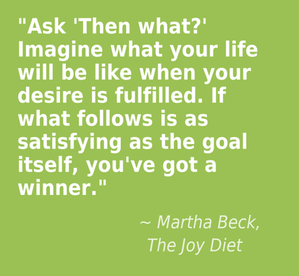I’m currently reading The Joy Diet by Martha Beck. It’s unexpectedly hilarious. Here’s a favorite quote describing her experience in yoga class: “Soothing sitar music plays as she demonstrates, one leg wrapped around her neck, the other folded into her armpit, her head (as far as I can tell) resting gently on the floor beside her buttocks. She looks like the very serene victim of a terrible crime. I could no more assume that position than I could fly to Neptune.”
Martha Beck says something about long-term goals that really resonated with me. She says it’s important to look at what you think you want, and see if it passes the “then what?” test. So frequently, we set goals and then once we achieve them, aren’t as happy as we expected we would be.
A classic example: Thinking that having a degree from a prestigious university will be rewarding in its own right. The true reward is the “then what?” that comes afterwards, which is that you will hopefully then be better prepared for success in a career you’re interested in, and it might be easier to find a job. What probably won’t happen: “Then I will feel fulfilled because I have a degree from Harvard!”.
How many purchases would you rethink if you ask yourself the “then what?” question? Will zealously working on an aspect of your appearance actually change your daily experience?
If I’d taken time to deeply reflect on the “then what?” in choosing life goals for myself, I probably would have chosen a different undergraduate major, and a different graduate school and career path. I entered college hoping to become a writer, and let one horrendous poetry class and a few fun history classes shift my trajectory. My heart still wishes I were a writer. I started this blog thinking the “then what” was going to be that I’d be motivated to record and therefore complete my half marathon training. The “then what” that happened was that I enjoyed interacting with other runners and writing so much that I haven’t stopped.
How this applies to fitness goals: Asking “then what?” can help us identify better fitness goals for ourselves. For example, in Gretchen Rubin’s new book about habits, I read about someone whose fitness goal was to achieve a six pack before his 30th birthday. He achieved that goal, but there was no “then what?” waiting for him. Sure, he could cross it off his bucket list, but he didn’t enjoy the required exercise enough to maintain the six pack. He worked hard to achieve those results, and earned fleeting satisfaction at best. (I hope he took some photos. But then he might look at them and feel the loss of his six pack more acutely.)
A better fitness goal might have been to find a fitness routine he loved and could stick with by the time he was 30, so that he’d reach the ages of 40 and 50 in better health, and obtain all the positive benefits of exercise along the way.
I thought when I ran my first half marathon that my “then what?” was simply that I would always know I had the spirit and determination to train for and run 13.1 miles. I also looked forward to being physically fit enough to run 6 or 7 miles at a time in the months that followed. That was enough for me at the time.
What I discovered was that the reward for my running was more running. I was better able to enjoy long, leisurely runs. I could handle a few extra hills when I was out with the jogging stroller. Running more meant I could run more, which made me interested in running more. Half marathons pass my “then what?” test with flying colors.
What passes yours?
